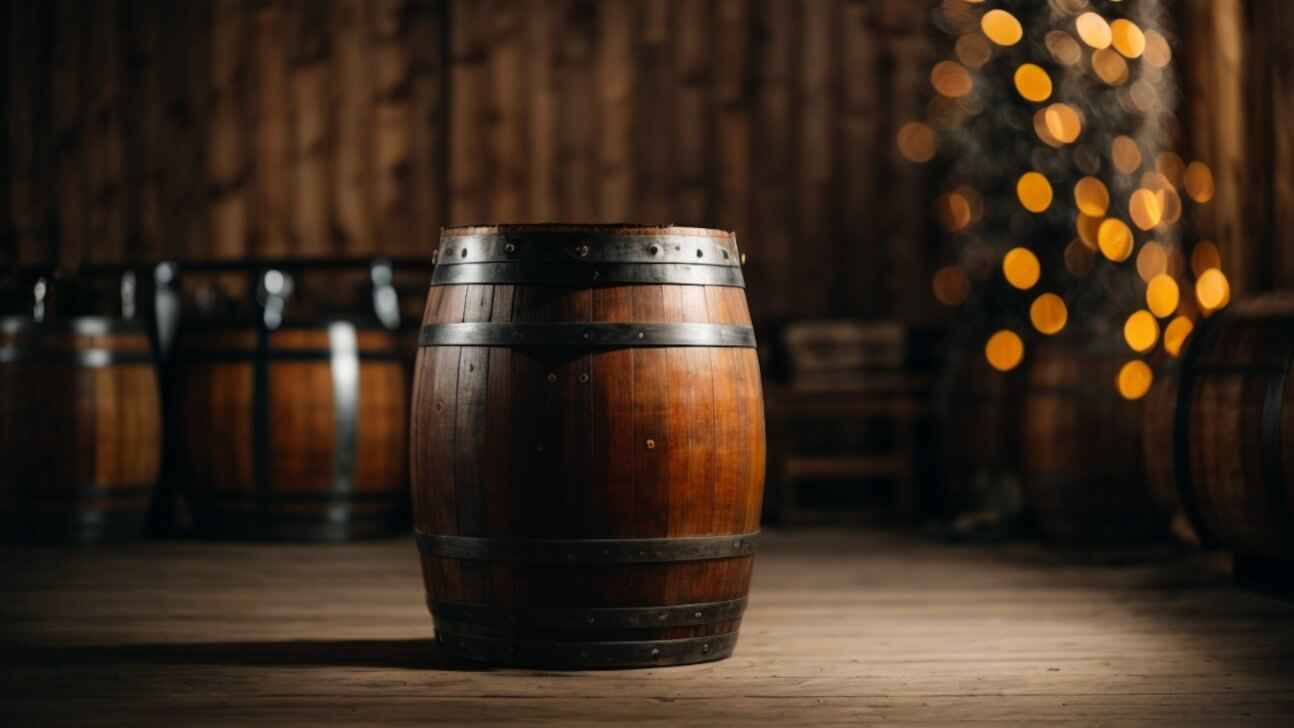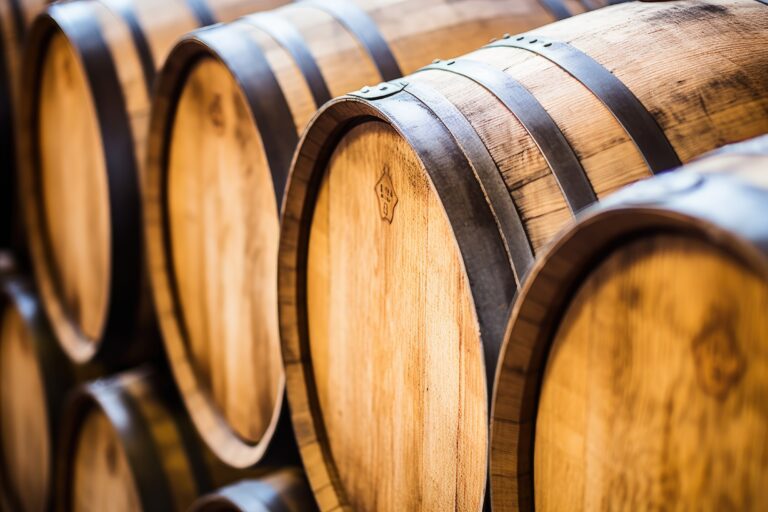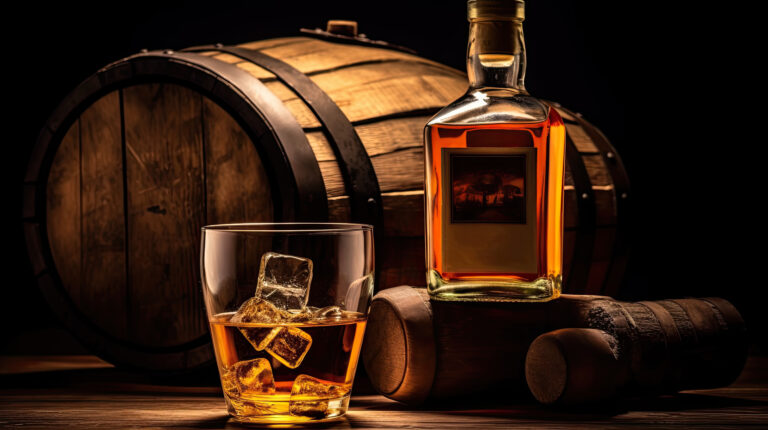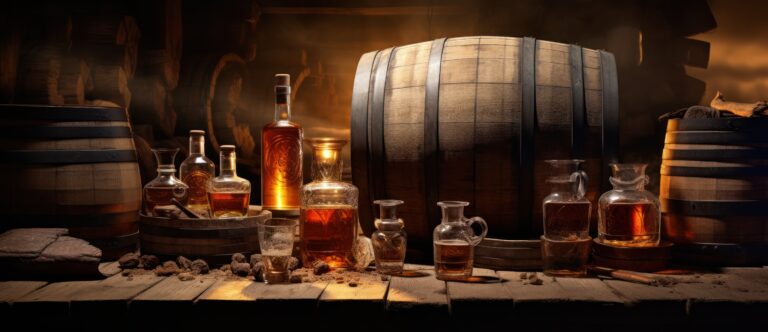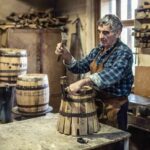So, you’re finally gearing up for that long-awaited trip to Kentucky bourbon country. You’ve booked your tours, made dining reservations, and researched the best B&Bs. But while you’re enjoying small-batch bourbons and taking in the stunning scenery, a question keeps popping into your mind: Just how tall is a whiskey barrel, anyway? You’ve seen pictures of rickhouses filled with barrels stacked high, but it’s tough to gauge their size. Before you head south, let’s satisfy your curiosity about one of the most iconic symbols of American whiskey. The barrels used for aging bourbon and rye are crafted to specific dimensions for good reasons. Let’s dive into why whiskey barrels have their unique shape and size, and how they contribute to the distinct flavor of American whiskeys. By the end of this post, you’ll be well-versed in all things related to whiskey barrels and ready to impress your fellow distillery visitors.
Introduction: The Allure of Whiskey Barrels
The charm of whiskey barrels is hard to resist. These oak casks bring a sense of rustic elegance and tradition. But have you ever stopped to think about the actual size of whiskey barrels?
Barrel sizes can differ, but a standard wooden barrel used for aging bourbon whiskey in the U.S. typically holds 53 gallons, which is about 200 liters. These barrels are approximately 32 to 34 inches tall and have a diameter of 24 inches. That’s just under 3 feet in height and 2 feet in width—definitely substantial containers!
The oak barrels are crafted from American white oak, featuring staves that are slightly curved and secured with metal hoops. Inside, the wood is charred, which enhances the flavor and color of the whiskey as it ages. As the whiskey interacts with the wood, it develops notes of vanilla, caramel, and spice.
The dimensions and shape of the barrels play a crucial role in the aging process of whiskey. A larger surface area allows for more interaction with the wood, while a smaller barrel can accelerate the aging process. The right balance between barrel size and aging duration creates the unique characteristics found in various whiskeys.
Whether you’re a whiskey enthusiast or just beginning to delve into the realm of fine spirits, barrel aging is a vital component in crafting a premium whiskey. So, the next time you encounter those iconic barrels, you’ll have a deeper appreciation for their contribution to the creation of a rich, smooth flavor. Cheers!
Standard Dimensions: Height, Width, and Volume
A typical whiskey barrel measures about 3 feet in height and 2 feet in width. While it may not appear large, these barrels can hold a significant amount of aged whiskey! The standard 53-gallon barrel contains approximately 63.5 liters of whiskey. Although barrels come in various sizes, the most common are the standard 53-gallon and the smaller 30-gallon.
Height
Standing at around 36 inches tall, a 53-gallon barrel reaches about mid-thigh on an average adult. This height facilitates efficient storage and transportation, making it manageable for distillery workers to move and fill. Barrels are stored on their sides, so the height influences how many can be stacked on top of one another. The shorter 30-gallon barrels are easier to maneuver but hold less whiskey and can’t be stacked as high.
Diameter
With a diameter of 24 inches, a 53-gallon barrel features a broad, rounded shape that is perfect for aging whiskey. This width maximizes the whiskey’s exposure to the wood, enhancing flavor absorption. Additionally, wider barrels provide more “headspace” above the whiskey, which captures air and promotes optimal oxidation and evaporation during the aging process. The rounded design is sturdier than a square container, helping the staves stay intact under the pressure of the whiskey inside.
Volume
A standard barrel holds 53 gallons or 201 liters of whiskey, which is enough to age properly and yield between 150 to 200 bottles when it’s ready for bottling. The large volume is essential because some whiskey is lost to evaporation during aging, a phenomenon known as the “angel’s share.” The size of the barrel also influences the aging duration needed to achieve the desired flavor, typically ranging from 3 to 50 years for whiskey. Smaller barrels tend to age more quickly, while larger ones require more time.
History and Evolution of Barrel Sizes Over Time
Barrel sizes have changed significantly throughout the centuries of whisky production. Initially, barrels served as the most practical containers for transporting and storing liquids. As distillation methods advanced, barrel sizes became standardized to enhance the aging process and flavor development.
Early Days
In the early days of whisky production in Scotland and Ireland, barrels were not specifically designed for aging spirits. Coopers utilized whatever staves and hoops were available to create containers for transport and short-term storage. As a result, sizes varied widely and were not ideal for maturation.
Enter the Butt
With the growing popularity of whisky, the butt emerged as a standard size in the early 1700s. Holding approximately 500 liters, butts were initially used for sherry, port, and rum. Distillers discovered that butts were excellent for aging whisky, as they imparted flavors from their previous contents. Butts remained prevalent until the mid-1800s.
Hogsheads Dominate
Starting in the 1750s, hogsheads became the most commonly used barrel for Scotch whisky. Typically ranging from 250 to 300 liters, hogsheads were more cost-effective to produce than butts, required less wood, and were easier to manage. Hogsheads remained the dominant choice for over a century and are still used for some single malts today.
The Rise of the Bourbon Barrel
In the early 1800s, bourbon distillers in Kentucky began using 200-liter barrels. This smaller size allowed for more wood contact, which sped up the maturation process. When American oak replaced European wood, the distinct flavors of bourbon started to develop. Today, oak bourbon barrels are often used to finish and age single malts, particularly those that are peated.
Today’s Barrels
While 200 liters is still the standard, some distillers are now opting for smaller barrels (100-150 liters) for specific expressions. Traditional distilleries continue to use larger hogsheads and butts. The choice of barrels today is influenced by the desired flavor profile and maturation period. After centuries of development, coopers and distillers have a wide range of proven options to select from.
Factors That Influence Barrel Height
The height of a whiskey barrel is influenced by several factors, all of which play a role in how the spirit matures and develops its flavor. Let’s take a closer look at some of the key elements that determine barrel height.
Wood Type
The type of wood used, whether it’s American white oak or European oak, affects the height of the barrel. American white oak barrels are generally shorter and stouter, measuring about 54 inches tall, while European oak barrels are typically taller, ranging from 60 to 72 inches. The wood type also influences maturation rates, with American oak imparting flavors more quickly than European oak.
Barrel Char
The degree to which the inside of the barrel is charred or burned also impacts its height. Heavily charred barrels, like those used for bourbon, are usually shorter because the charred wood is more porous, facilitating faster flavor extraction. In contrast, lightly charred barrels, used for whiskeys such as scotch or Irish whiskey, tend to be taller to accommodate the longer maturation period required.
Spirit Type
The specific type of spirit—be it bourbon, scotch, or rum—that will be aged in the barrel also affects its dimensions. Barrels intended for aging bourbon are typically around 54 inches tall, while those for scotch whisky are often taller, between 60 to 72 inches, to allow for extended aging. Rum barrels also tend to be on the taller side.
Maturation Time
The duration for which the spirit will mature in the barrel is another factor that determines its height. Shorter barrels are commonly used for spirits that age for shorter periods, like bourbon, while taller barrels are generally reserved for longer-aged spirits such as scotch or rum. The extra height provides more airflow and surface area for interaction with the spirit during the extended maturation process.
Ultimately, as with many aspects of distilling, barrel height is about achieving balance and harmony. The factors of wood type, char level, spirit variety, and maturation time all work together to determine the ideal height for any whiskey barrel.
How Barrel Size Impacts Whiskey Aging
The size of a whiskey barrel significantly influences how the spirit ages and develops its flavor profile. The most commonly used sizes are the standard barrel, which holds 53 gallons, and the double barrel, with a capacity of 59 gallons.
How Much Whiskey Goes in a Barrel?
A standard 53-gallon barrel usually contains between 50 to 60 gallons of distilled spirit. The exact amount can vary based on factors such as barrel char, wood type, and the preferences of the distiller. A larger volume of whiskey in the barrel increases the surface area in contact with the wood, which affects both the color and flavor development.
Surface Area and Oxygen Exposure
The dimensions of a barrel dictate the surface area of whiskey that interacts with the wood. A greater surface area leads to more interaction and a faster aging process. Additionally, the size of the barrel opening influences oxygen exposure, which is crucial for breaking down compounds in the whiskey that contribute to its aroma and flavor. Wider openings allow for more oxygen contact, thereby speeding up the aging process.
Barrel Size and Maturation Rate
Generally, smaller types of barrels age whiskey more quickly than larger ones due to the increased surface area relative to their volume. Whiskey in a small barrel can reach full maturity in just 6 to 12 months, while a standard barrel typically requires 2 to 5 years. However, the downside of smaller barrels is that they can lead to excessive wood contact, resulting in over-oaking if the whiskey is left to age for too long.
Cask Strength and Angel’s Share
As whiskey ages in the barrel, it naturally evaporates—this phenomenon is referred to as the angel’s share. In smaller barrels, the angel’s share tends to be greater due to the increased surface area and exposure to oxygen. This results in a larger loss of whiskey to evaporation, which ultimately reduces the overall yield. However, since there is less whiskey in the barrel, the remaining liquid has a more concentrated flavor at cask strength.
Ultimately, the choice of barrel size involves a balance between maturation rate, wood influence, cask strength, and yield. Smaller barrels speed up the aging process and elevate cask strength, while larger barrels yield more whiskey but allow for a slower, more nuanced maturation. The ideal barrel size ultimately hinges on the distiller’s vision for their whiskey.
Unique Barrel Shapes and Sizes
Barrel shapes and sizes can differ significantly based on the type of whiskey and the distillery’s whiskey-making process. The most prevalent shapes include charred oak barrels, typically used for aging bourbon, and hogsheads, which are favored for Scotch whisky. However, some distilleries take a more innovative approach with their barrel designs.
Unique Barrel Shapes
Certain distilleries play around with barrel shapes to create unique flavors in their whiskies. For instance, Maker’s Mark employs lightly toasted barrel staves, resulting in a bourbon that has a mellow and smooth profile. Others opt for more rounded barrel heads instead of flat ones, which enhances the ratio of charred wood surface area to the whiskey volume.
Small Barrels
Small barrels, usually ranging from 5 to 15 gallons, are utilized to accelerate the aging process and amplify the flavor. The higher wood-to-whiskey ratio allows the whiskey to absorb the wood’s characteristics more quickly. Whiskeys aged in these smaller barrels often exhibit a darker hue and stronger wood notes, such as vanilla, caramel, and spice. Many craft distilleries leverage small barrels to create unique artisanal whiskies.
Large Barrels
Conversely, there are massive barrels, like the 20,000-liter ones used by Glenfiddich distillery in Scotland. While these large barrels are more economical, their reduced wood-to-whiskey ratio results in a slower aging process, leading to lighter and more subtle flavors. Very large barrels can yield whiskies with pronounced fruity and floral notes. Regardless of size or shape, charred oak barrels play a crucial role in imparting whiskey’s signature amber color and oaky, vanilla-infused flavor profile. Aging whisky in barrels—whether they are enormous or small, traditional or unconventional—is truly an art. The outcomes, as any whiskey enthusiast will attest, can be nothing short of magical.
Measuring Your Own Barrels: Dos and Don’ts
Now that you have your whiskey barrels, it’s crucial to measure them accurately before filling or using them. Following some do’s and don’ts will help you achieve precise measurements and make the most of your barrels.
Do measure when the barrel is empty.
It’s easiest to get accurate dimensions when the barrel is unfilled. Use a tape measure to check the diameter across the middle of the barrel, as well as the height from the bottom rim to the top rim. Make sure to jot down these numbers for future reference.
Do measure in inches.
Barrel dimensions are usually provided in inches. So, ensure you have a tape measure that displays inches to obtain the correct measurements. Measuring in centimeters might cause confusion later on.
Don’t assume all barrels are the same size.
Whiskey barrels vary in size, ranging from small 5-gallon barrels to large 59-gallon hogsheads. Therefore, measure each barrel individually to capture its unique dimensions. Avoid relying on averages or estimates.
Do measure the diameter of the barrel head.
In addition to measuring the middle diameter, also check the diameter of the top barrel head. The barrel head is often slightly larger, so knowing the measurement of the largest part of the barrel is essential. This ensures that anything going into or coming out of the barrel will fit properly.
Don’t forget to measure the bung hole.
The bung hole, or barrel opening, also comes in various sizes. Measure its diameter to determine the appropriate size bung, or barrel plug, needed for sealing the barrel. Choosing the wrong size could result in leaks, spills, or oxidation.
By carefully measuring your whiskey barrels when they are empty, recording all dimensions in inches, and avoiding assumptions, you’ll have the precise measurements necessary to fully utilize your barrels. Your attention to detail will lead to improved fermentation, aging, and bottling results in the future.
Fun Facts and Trivia About Whiskey Barrels
Have you ever thought about the size of a whiskey barrel? These oak casks are crucial for aging and flavoring whiskey, yet their dimensions often remain unclear. Here are some interesting facts and trivia to help you understand the scale of these iconic barrels:
- Whiskey barrels typically hold around 53 gallons or 200 liters of whiskey. That’s quite a bit of spirit! The large capacity is essential for the lengthy aging process, as a significant amount of the whiskey evaporates over time, a phenomenon known as the “angel’s share.”
- Barrels are about 3 feet tall, measuring roughly 34 to 36 inches in height. They have a rounded shape that bulges in the middle, with a diameter of about 2 feet or 24 inches.
- A fully loaded 53-gallon barrel weighs nearly 600 pounds or 272 kilograms. When whiskey is aging, the barrel is placed on its side to maximize the surface area that comes into contact with oxygen, enhancing flavor interaction. Moving these heavy barrels requires specialized equipment and training.
- The standard shape of whiskey barrels has remained largely unchanged for centuries. The classic design, featuring bowed staves and steel hoops, dates back to the early 1700s. While production techniques have evolved, the traditional form is still perfect for aging whiskey.
- A single 53-gallon barrel can yield around 150 to 200 bottles of whiskey, depending on the type and size of the bottles. This means each barrel contributes a significant amount of flavor during the aging process.
- Barrels are generally used to age whiskey for periods ranging from 3 years to over 50 years. As whiskey matures, it absorbs flavors and aromas from the charred oak, giving aged spirits their rich brown color and complex taste.
- Bourbon whiskey must be aged in new, charred oak barrels. Other whiskey varieties can utilize refill barrels, but new barrels provide a stronger oak flavor to the spirit.
- Barrels need regular maintenance and eventual replacement. After several uses, they may begin to leak and lose their structural integrity, so distillers keep a close eye on barrel conditions throughout the aging process.
It’s pretty remarkable how a simple, traditional container can significantly influence one of the world’s most cherished spirits. Whiskey and barrels have been closely linked for generations.
FAQs: Answering Common Whiskey Barrel Questions
Have you ever wondered how tall a whiskey barrel actually is? Whiskey barrels vary in size, but a standard US whiskey barrel typically holds around 53 gallons. Barrel sizes are defined by their capacity in US gallons. The most common sizes include:
- 53 gallons (200 liters): This is the standard size for US whiskey barrels, often referred to as a “bourbon barrel.”
- 59 gallons (225 liters): Used for certain whiskeys and brandies.
- 63 gallons (240 liters): Also utilized for some whiskeys and brandies.
How tall is a 53-gallon whiskey barrel?
A 53-gallon whiskey barrel usually stands between 34 to 36 inches (86 to 91 cm) tall and has a diameter of about 24 inches (61 cm). The exact measurements can vary slightly depending on the cooperage and distillery.
Why do barrel sizes matter?
The size of the barrel affects its whiskey-holding capacity, which in turn influences the aging process. A smaller barrel has more surface area, leading to greater interaction between the whiskey and the wood, often resulting in quicker aging and enhanced barrel flavor. Smaller barrels are frequently used for small batch and single barrel whiskeys to accelerate aging. In contrast, larger barrels are more common in high-volume production, allowing for more whiskey to be aged simultaneously.
Are all whiskey barrels made of oak?
Most whiskey barrels are crafted from American white oak (Quercus alba) or European oak (Quercus robur). Oak is the preferred material for aging whiskey due to its porous nature, which adds flavor through the wood’s compounds and aids in oxidation. Some distilleries experiment with barrels made from hickory, maple, or chestnut wood.
How long are whiskey barrels used?
Whiskey barrels are generally used for aging whiskey for a period of 3 to 60 years, depending on the whiskey type. During aging, the barrels contribute flavor and color to the whiskey. After a barrel has been used once, it loses some of its flavoring ability. Most barrels are reused 2-3 times before being retired, while some are repurposed more frequently for spirits with milder flavors. Used barrels are often sold for aging other spirits like rum, tequila, and wine, or repurposed for decorative purposes.
Final Thoughts
Now you know the exact dimensions of a standard whiskey barrel. It’s pretty interesting to finally uncover that detail, isn’t it? The next time you’re enjoying a glass of bourbon, you can confidently share with your friends that each bottle originates from a charred oak barrel that’s almost 3 feet tall and 2 feet wide. You’ve joined an exclusive group with some insider whiskey knowledge. But don’t get too ahead of yourself—there’s still a vast array of whiskey facts waiting to be explored. Keep reading, keep learning, and most importantly, savor that delightful amber elixir we call whiskey. The journey goes on!
